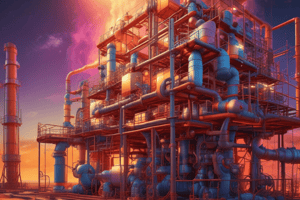Podcast
Questions and Answers
What occurs on the surface of a silicon wafer when exposed to oxygen?
What occurs on the surface of a silicon wafer when exposed to oxygen?
- Formation of Silicon Nitrate
- Formation of Silicon Carbide
- Formation of Silicon Dioxide (correct)
- Formation of Silicon Hydride
Which oxidation method is faster?
Which oxidation method is faster?
- Dry oxidation
- Chemical oxidation
- Wet oxidation (correct)
- Plasma oxidation
What is a characteristic of thicker oxide layers during the oxidation process?
What is a characteristic of thicker oxide layers during the oxidation process?
- No growth at all
- Slower growth rate (correct)
- Faster growth rate
- Constant growth rate
What is one use of silicon dioxide in semiconductor fabrication?
What is one use of silicon dioxide in semiconductor fabrication?
What determines the thickness of the silicon dioxide layer produced during oxidation?
What determines the thickness of the silicon dioxide layer produced during oxidation?
In the oxidation reaction Si + O2 → SiO2, what is being oxidized?
In the oxidation reaction Si + O2 → SiO2, what is being oxidized?
What effect does higher temperature have on the oxidation process?
What effect does higher temperature have on the oxidation process?
What is a primary characteristic of wet oxidation compared to dry oxidation?
What is a primary characteristic of wet oxidation compared to dry oxidation?
In which application is wet oxidation primarily employed?
In which application is wet oxidation primarily employed?
What is a benefit of using dry oxidation for creating thin gate oxides in MOS devices?
What is a benefit of using dry oxidation for creating thin gate oxides in MOS devices?
What chemical reaction represents the process of dry oxidation?
What chemical reaction represents the process of dry oxidation?
Why is a dry-wet-dry sequence employed in the oxidation process?
Why is a dry-wet-dry sequence employed in the oxidation process?
What is the primary drawback of wet oxidation?
What is the primary drawback of wet oxidation?
For which of the following is dry oxidation NOT primarily used?
For which of the following is dry oxidation NOT primarily used?
What type of oxide is formed at the silicon-oxide interface during the oxidation process?
What type of oxide is formed at the silicon-oxide interface during the oxidation process?
Flashcards are hidden until you start studying
Study Notes
Thermal Oxidation of Silicon
- Silicon wafers oxidize to create silicon dioxide (SiO2) when exposed to oxygen.
- Variation in SiO2 thickness results in different colors on the wafer.
Uses of Silicon Dioxide
- Acts as gate or dielectric oxide in electronic devices.
- Serves as an electrical insulator.
- Functions as a barrier during diffusion processes for introducing dopants.
Oxidation Process
- Thermal oxidation occurs when the silicon wafer is heated between 900°C to 1200°C.
- Two oxidation methods:
- Wet Oxidation: Reaction is Si + 2H2O → SiO2 + 2H2.
- Dry Oxidation: Reaction is Si + O2 → SiO2.
Oxidation Growth
- Growth rates differ between wet and dry oxidation.
- Wet oxidation is quicker than dry oxidation.
- Oxide thickness increases with longer oxidation time and higher temperatures.
- The growth mechanism involves oxygen traveling through the existing oxide layer to react with silicon at the interface, resulting in differing growth rates based on thickness.
Oxide Quality and Applications
- Wet oxide has lower density but is efficient for creating thick barrier layers.
- Dry oxide, although slower, has a higher density and better quality, suitable for thin applications.
- Wet oxidation is suitable for masking dopants during high-temperature diffusion to form p or n regions.
- Thin gate oxides for MOS devices are created through dry oxidation due to quality control advantages.
- A sequence of dry-wet-dry oxidation is often used to sandwich thicker, lower quality oxide with thin, high quality oxide for better overall results.
Summary
- Dry Oxidation: Yields high-quality oxide, slower process; ideal for gate oxides and dielectrics.
- Wet Oxidation: Fast process but with lower quality; used for isolation and diffusion masking.
Studying That Suits You
Use AI to generate personalized quizzes and flashcards to suit your learning preferences.




